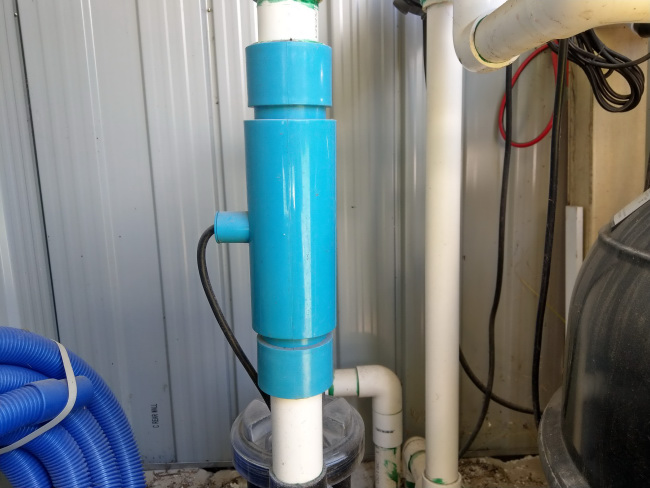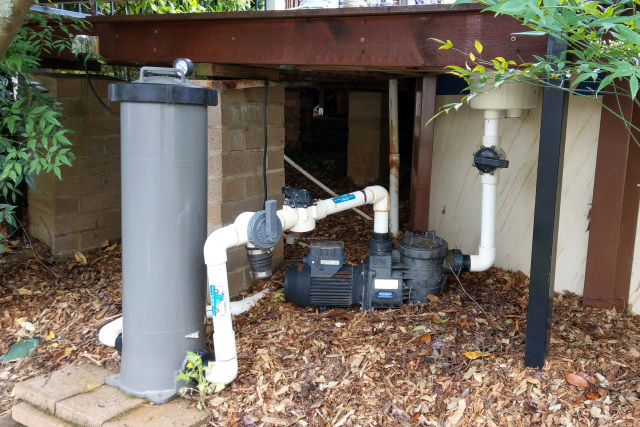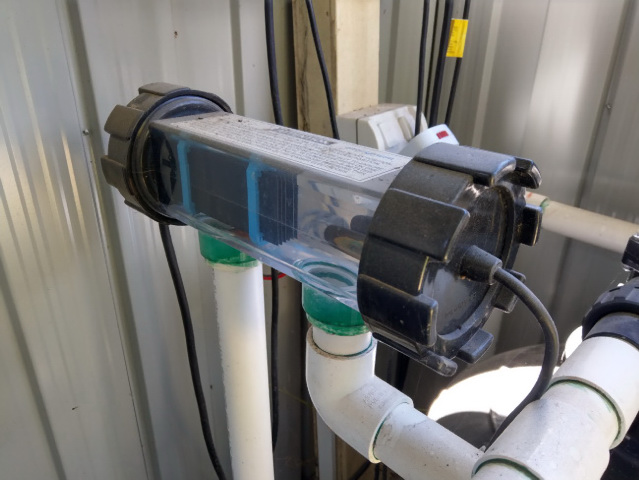The saltwater generator (aka salt cell, SWG, chlorine generator or chlorinator) ensures that the pool water remains safe for swimming. To do this, the chlorine generator and pool pump need to run long enough to clean the water.
So how long should you leave the saltwater system running? And what happens when you don’t run it long enough?
The answers to these questions and more will be revealed in this post. Let’s dive in.
Article Contents
How Long To Run The Saltwater Generator For?
The chlorine generator should be left running long enough to produce the amount of chlorine needed to sanitize the pool daily. On average, this takes between 8 and 12 hours depending on the pool size, type of saltwater generator, and the output level the chlorine generator has been set to.

Saltwater chlorine generator control panel.
The ideal saltwater chlorine generator output is between 50% and 70%. If the saltwater system output is set too low, then you’ll need to run the chlorine generator for a longer time. We’ll go deeper into the chlorine generator output later in this article.
You should also keep tabs on the chlorine levels in the pool before you turn on the chlorine generator, so you can adjust your chlorine generator to the ideal power output.
The ideal chlorine level for saltwater pools is between 3 and 5 ppm. If the chlorine level is above 5ppm, then you’ll need to either reduce the number of hours the chlorine generator runs or reduce the power level.
If the chlorine is less than 3ppm, then you will need to run the chlorine generator for a longer time or increase the power level.
You can also use a pool timer to automate the operation of the chlorine generator and pump. With a timer, you can set the chlorinator (chlorine generator) to automatically turn on and shut off. Some saltwater chlorine generator systems are even designed with a built-in timer.
You should also know that the pool pump has to be running for the saltwater cell to work. If water isn’t circulating through the salt cell, then the salt cell will not turn on.
In fact, most systems use a flow sensor. If the water flow is too low, the saltwater system will not turn on. So if the pool pump isn’t running and you try to turn on the saltwater system, the salt cell will not work or produce chlorine.

There may of course be other reasons your saltwater generator isn’t working. We have an article on this:
13 Reasons Why Saltwater Generator IS Not Working or Generating Chlorine
How Long To Run a Saltwater Pool Pump For?
The pool pump in a saltwater pool should be run 8 to 12 hours per day on average. In saltwater pools, the pump needs to be on for two reasons. The first is to filter the water. The pump should complete at least one turnover of the pool water to filter it properly. The second reason is for the saltwater chlorine generator to produce enough chlorine.
Filtering
A saltwater pool pump will need to pump the water through the pool’s filter just like a chlorine pool. The pool’s water should be turned over at least once a day.

Turnover is a term used to describe circulating all the pool’s water through the filtration system.
You can calculate how long you need to run the pool pump for by dividing the gallons per hour (gph) of the pool pump by the size (in gallons) of the pool. For instance, a pool pump that moves 3000 gallons of water per hour needs to be run for 8 hours to complete the turnover of a 24,000 gallon pool.
You should also know that it’s advised to turnover the pool’s water twice daily. Find out more about how and when to run your pool pump in this article.
Chlorine Generation
The second reason a saltwater pool pump needs to run is for the chlorine generator (SWG) to work. Without water flowing through the salt cell the chlorine generator (chlorinator) can not produce chlorine.
On average, most pools will need the saltwater generator to be on 8-12 hours per day. This will produce adequate levels of chlorine to properly sanitize the pool’s water. For proper sanitization, the chlorine levels should be 3-5 ppm.
So what happens when you don’t run the chlorine generator or pool pump long enough? Let’s find out.
What Happens If The Chlorine Generator Is Not On Long Enough?
If you don’t run the saltwater generator (sometimes called a chlorinator) long enough, you won’t have enough chlorine in the pool to sanitize the water. This will lead to low chlorine levels in the pool. And if chlorine levels are low, you’ll end up with murky or cloudy water, or even algae.
It could even mean your saltwater pool is unsafe to swim in. Here’s an article that lists the dangers of saltwater pools:
The Dangers of Salt Water Pools | Are they Safe?
Now let’s back up a minute and go into more depth on how saltwater pools work.
Many people are falsely informed when it comes to saltwater pools. They think salt is what sanitizes the water. This is incorrect.
Just like a regular chlorine pool, saltwater pools also use chlorine to sanitize the water. The only thing that differs is that in a regular chlorine pool, the pool operator usually adds the chlorine by hand. Think liquid chlorine, chlorine tablets, or chlorine powder.
In a saltwater pool, the chlorine is made by the saltwater generator system (chlorinator) and added to the water automatically without the need to manually add it. The salt in the pool water is converted to chlorine by the salt cell. This process is called electrolysis.
There may be some instances where you need to add additional chlorine to your saltwater pool. You can read more about that here: Is it OK to Put Chlorine in a Saltwater Pool? (answered!)

What Happens If The Pool Pump Is Not On Long Enough?
When the pool pump isn’t on, the chlorine generator will not work.
That’s why it’s crucial for the pool pump in a saltwater pool to be on for the right amount of time. Most pools need the chlorine generator to be on for 8-12 hours per day. This will produce enough chlorine to properly sanitize the water.
What Does Saltwater Generator Output Mean?
Every saltwater system or saltwater chlorine generator has a control panel with a variable output. This allows the pool owner to control the chlorine levels in the pool.
The chlorine output is measured in percentage. The percentage output determines how much chlorine will be produced by the chlorine generator.
e.g. 50% power will generate 50% of the generator’s maximum rated chlorine output.
Salt water systems, regardless of brand, are rated based on the grams of chlorine they produce per hour (GPH). For instance, the Auto Chlor RP25 produces 25 grams of chlorine per hour. When set to 100% output and set to run for 10 hours, the salt system will produce 250 grams of chlorine (25×10).
If set to 50% output, the saltwater system will produce half of the maximum output. This works out to 12.5 grams of chlorine per hour.
It’s generally recommended to set the output between 50 and 70%. This will maximize the salt cell’s life. Running the salt cell on maximum will greatly decrease the lifetime of it.
Now that you know how the saltwater generator output works, let’s check out how to adjust it.
How To Adjust Salt Water Generator Output
Adjusting the saltwater generator (SWG) output is a trial and error process.
Here is a guide on how to adjust and set the right chlorine output for your salt cell:
- Test the water chemistry and make sure the pH and stabilizer levels are correct. Note the chlorine level. The levels must be accurate before you change the chlorine generator output.
- Set the output to 50% and set the pump and system to run for 8 hours per day. Leave for 5 days.
- Test the pH, stabilizer and chlorine levels again.
- Adjust the generator output based on the level of chlorine in the pool. If the chlorine level is lower than when you started, then you need to increase the chlorine generator output. You need to have 3-5 ppm of chlorine in the pool. If it is above 5 ppm, reduce the output.
- Let the salt water chlorine generator run at the new output for another 5 days
- Re-test the chlorine levels. If you still don’t have at least 3 ppm of chlorine in the pool, you’ll have to increase the chlorine output again.
If you set the saltwater generator output to 80-90% and the chlorine levels still don’t hold steady at least 3 ppm of chlorine after 5 days, it could mean that:
- You need to run the system longer (8-12 hours is ideal)
- Your chlorine generator is too small for the pool
- You may have an algae problem and the pool may be using up chlorine quicker than the chlorine generator can produce it. You’ll need to get rid of the algae.
- The stabilizer levels are too low and the chlorine is getting “burnt” off by the sun.
If you don’t have a high quality test kit, I would recommend this one below. Inaccurate test kits are a bit reason pool water problems.
- For saltwater pools
- Extremely accurate
- Tests 7 things including salt, pH, chlorine, cyanuric acid
FAQs
What Should My Salt Water System Output Be Set At?
The output should be set at 50% and increased if the chlorine being produced at 50% isn’t enough. This is to maintain a chlorine level in your pool of 3-5 ppm.
The output you need to set the saltwater chlorine generate at will vary a little throughout the year. It will depend on the chlorine demand of the pool. Chlorine demand is affect by the water temperature, amount of debris in the pool, rain, bather load and the chemical balance of the pool.
How Long Should I Run The Saltwater Generator for During The Summer Months?
Run your saltwater system for 8-12 hours per day during the summer.
The weather is warmer in summer meaning that pools will be used more frequently to cool down. When pools are used frequently, there is a higher level of bather load, oils, and scum in the pool water. Meaning that you’ll need more chlorine to clear the water.
Warmer water also means faster bacterial and organic growth. More chlorine is needed to keep this under control.
Also, the sun will easily degrade the chlorine levels in the pool. So during the hot summer months, you’ll need to run the saltwater chlorine system for longer periods to produce enough chlorine to clean the pool and to replenish the chlorine being destroyed by the sun’s UV rays.
When Should I Add Salt To The Pool
You should add salt to the pool whenever the salt system indicates a low salt level in the pool. Most saltwater pools need to have a salt level of around 2500-3500 ppm.
You shouldn’t really need to add much salt to a swimming pool. Salt doesn’t evaporate or get used up. It only reduces when you take water out of the pool. Usually this is by splashing, backwashing or leaks.
Final Thoughts
Overall, you need to run your saltwater generator and pool pump for at least 8 hours daily. Not running either of these long enough means not enough chlorine to sanitize the water.
Remember, the pool pump needs to be running simultaneously with the chlorine generator for the salt cell to produce chlorine.
So there you have it. If you liked this post, ensure to check out others like it on this website for more painting tips.


